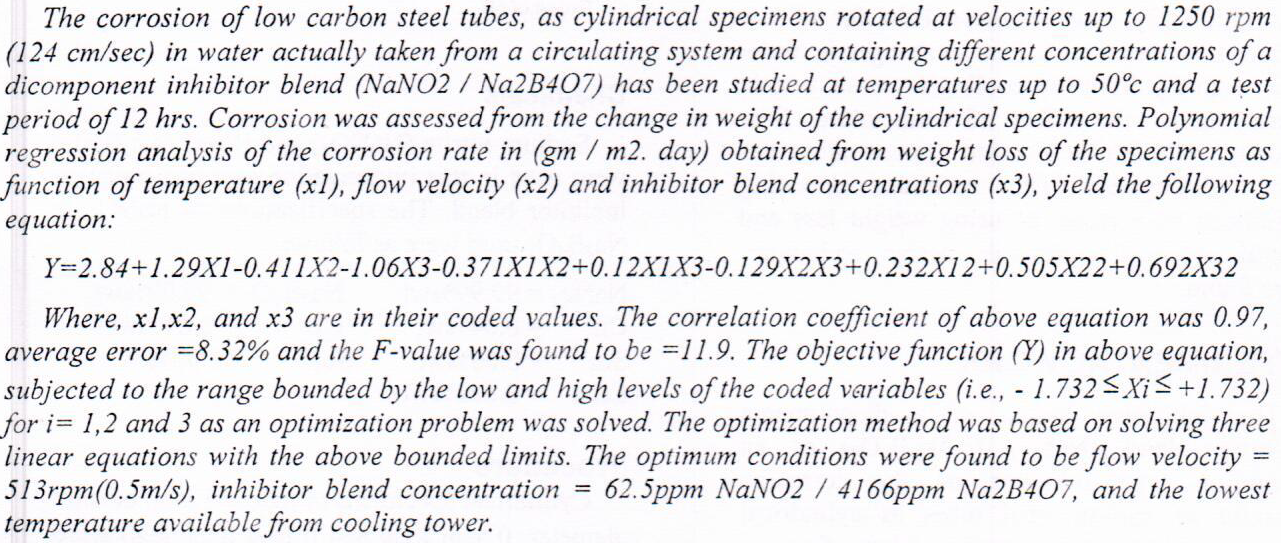
Massive multiple-input multiple-output (massive-MIMO) is considered as the key technology to meet the huge demands of data rates in the future wireless communications networks. However, for massive-MIMO systems to realize their maximum potential gain, sufficiently accurate downlink (DL) channel state information (CSI) with low overhead to meet the short coherence time (CT) is required. Therefore, this article aims to overcome the technical challenge of DL CSI estimation in a frequency-division-duplex (FDD) massive-MIMO with short CT considering five different physical correlation models. To this end, the statistical structure of the massive-MIMO channel, which is captured by the physical correlation is exploited to find sufficiently
... Show More (5)
(5)
 (5)
(5)
This paper investigated the fatigue life behavior of two composite materials subjected to different times of shot peening (2, 4 and 6 min).The first material prepared from unsaturated polyester with E-glass reinforcement by 33% volume fraction. While, the second one was prepared from unsaturated polyester with aluminum powder by2.5% volume fraction. The experimental results showed that the improvement in endurance limit was obtained (for the first material) at 2, 4 and 6 min shot peening times where the percentage of maximum improvement was 25% at shot peening time of 6 min. While, the endurance limit of the second material decreased at shot peening times of 2, 4 and 6 min where the percentage of maximum reduction was 29 % at shot peenin
... Show MoreAbstract
The problem of missing data represents a major obstacle before researchers in the process of data analysis in different fields since , this problem is a recurrent one in all fields of study including social , medical , astronomical and clinical experiments .
The presence of such a problem within the data to be studied may influence negatively on the analysis and it may lead to misleading conclusions , together with the fact that these conclusions that result from a great bias caused by that problem in spite of the efficiency of wavelet methods but they are also affected by the missing of data , in addition to the impact of the problem of miss of accuracy estimation
... Show MoreThe -mixing of - transition in Er 168 populated in Er)n,n(Er 168168 reaction is calculated in the present work by using a2- ratio method. This method has used in previou studies [4, 5, 6, 7] in case that the second transition is pure or for that transition which can be considered as pure only, but in one work we applied this method for two cases, in the first one for pure transition and in the 2nd one for non pure transitions. We take into accunt the experimental a2- coefficient for p revious works and -values for one transition only [1]. The results obtained are, in general, in agood agreement within associated errors, with those reported previously [1], the discrepancies that occur are due to inaccuracies existing
... Show MoreThis study examines the removal of ciprofloxacin in an aqueous solution using green tea silver nanoparticles (Ag-NPs). The synthesized Ag-NPs have been classified by the different techniques of SEM, AFM, BET, FTIR, and Zeta potential. Spherical nanoparticles with average sizes of 32 nm and a surface area of 1.2387m2/g are found to be silver nanoparticles. The results showed that the ciprofloxacin removal efficiency depends on the initial pH (2.5-10), CIP (2-15 mg/L), temperature (20-50°C), time (0-180 min), and Ag-NPs dosage (0.1-1g/L). Batch experiments revealed that the removal rate with ratio (1:1) (w/w) were 52%, and 79.8% of the 10 mg/L of CIP at 60, and 180 minutes, respectively with optimal pH=4. Kinetic models for adsorpti
... Show More (1)
(1)
This paper examines a new nonlinear system of multiple integro-differential equations containing symmetric matrices with impulsive actions. The numerical-analytic method of ordinary differential equations and Banach fixed point theorem are used to study the existence, uniqueness and stability of periodic solutions of impulsive integro-differential equations with piecewise continuous functions. This study is based on the Hölder condition in which the ordering , and are real numbers between 0 and 1.
 (1)
(1)
A new Schiff base complex was prepeard and characterized: Chloro –Oxo (bis(Ohydroxy benzaldehyde) O-phenylene di imination ) Vanadium (V) with general formula (VOLCL). Complex was studied by using Three different organics Organic The photo chemistry of this solvent with different polarity . These solvents were ( Acetone,pyridinest chloro form) . It was found that the chelate Vanadium (V) complex decomposed photochemically in these solvents during . In the tra oxidation –reduction reaction leading to free radical derived in the ligand of shiff base ℓ .Vanadium IV chelate complex . It was also found that the quantum yield of photo decomposition (фd) and Activity ratio did not de
... Show MoreThe present study is to investigate the possibility of using wastes in the form of scrap iron (ZVI) and/ or aluminum ZVAI for the detention and immobilization of the chromium ions in simulated wastewater. Different batch equilibrium parameters such as contact time (0-250) min, sorbent dose (2-8 g ZVI/100 mL and 0.2-1 g ZVAI/100 mL), initial pH (3-6), initial pollutant concentration of 50 mg/L, and speed of agitation (0-250) rpm were investigated. Maximum contaminant removal efficiency corresponding to (96 %) at 250 min contact time, 1g ZVAI/ 6g ZVI sorbent mass ratio, pH 5.5, pollutant concentration of 50 mg/L initially, and 250 rpm agitation speed were obtained.
The best isotherm model for the batch single Cr(III) uptake by ZVI
... Show More (12)
(12)
Spectrophotometric method was developed for the determination of copper(II) ion. Synthesized (2,2[O-Tolidine-4,4-bis azo]bis[4,5-diphenyl imidazole]) (MBBAI) was used as chromogenic reagent at pH=5. Various factors affecting complex formation, such as, pH effect, reagent concentration, time effect and temperature effect, have been considered and studied. Under optimum conditions concentration ranged from (5.00-80.00) µg/mL of copper(II) obeyed Beer`s Low. Maximum absorption of the complex was 409nm with molar absorpitivity 0.127x104 L mol-1 cm-1. Limit of detection(LOD) and Limit of quantification were 1.924 and 6.42 μg/mL, respectively.
... Show More (5)
(5)
